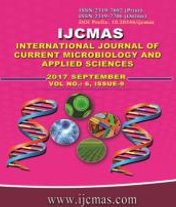


 National Academy of Agricultural Sciences (NAAS)
National Academy of Agricultural Sciences (NAAS)

|
PRINT ISSN : 2319-7692
Online ISSN : 2319-7706 Issues : 12 per year Publisher : Excellent Publishers Email : editorijcmas@gmail.com / submit@ijcmas.com Editor-in-chief: Dr.M.Prakash Index Copernicus ICV 2018: 95.39 NAAS RATING 2020: 5.38 |
The present study was conducted to investigate the effect of dietary supplementations of inorganic, organic and nano Zn on carcass characteristics and bone morphometric study in broiler chickens. A total of 300 day-old straight run broiler chicken were randomly assigned to 10 dietary treatments each consisting of 3 replicates and each replicate having 10 chicks for a period of 6 weeks. The dietary treatments includes corn-soybean meal based basal diet as control (T1) or the basal diet supplemented either with 40 or 80 mg of Zn/kg of feed from each sources, such as Zn oxide (T2 and T3), Zn sulphate (T4 and T5), Zn-methionine (T6 and T7) and Zn-protienate (T8 and T9) except that the nano-Zn which was supplemented only at 20 mg/kg (T10). At the day 42, two birds from each replicate were taken randomly for the slaughter study. The highest eviscerated weight (%) observed in the group fed with 40 mg Zn-protienate (T8) which was non-significant (p>0.05). Ready-to-cook yield, cut-up parts and giblet (%) did not show any significant (p>0.05) difference between experimental groups. Regarding bone morphometric parameters such as bone weight, length and width, a non-significant (p>0.05) difference exist among the treatment groups. It was concluded that the dietary inclusion of inorganic, organic and nano Zn did not show any significant difference on the carcass yields and bone morphometric parameters.
 |
 |
 |
 |
 |